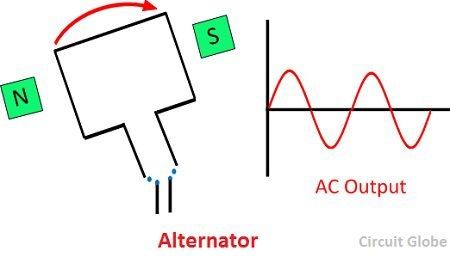The major difference between the alternator and the generator is that in alternator the armature is stationary and the field system rotates whereas in the generator armature rotates and field is stationary. The armature of the alternator is mounted on the stationary element called stator and field winding on a rotating element. While the connection of a generator is just the reverse of it. The other differences between them are shown below in the comparison chart.
The alternator and generator both works on the principle of Faraday law of electromagnetic induction. The generator induces both the alternating and direct current and the alternator produces only alternating current. The rotor of the generator is placed inside the stationary magnetic field. The stationary magnetic field is produced by the magnetic poles. The rotor moves inside the magnetic field, intersects the magnetic line of force which induces the current in the wire.
Every half rotation of rotor changes the direction of the current which causes the alternating current. For getting the alternating current, the ends of the circuit is directly connected to the load. But for producing the direct current, the ends of the wire is connected to the commutator. The commutator converts the alternating current into direct current.
Content: Alternator Vs Generator
Comparison Chart
| Basis for Comparison | Alternator | Generator |
|---|---|---|
| Definition | A machine that converts the mechanical energy into AC electrical power. | A machine that changes mechanical energy into electrical energy (AC or DC). |
| Current | Induces alternating current | Generate both AC & DC. |
| Magnetic Field | Rotating | Stationary |
| Input Supply | Takes from stator. | Takes from rotor. |
| Armature | Stationary | Rotatory |
| Output EMF | Alternating | Constant |
| RPM (Rotation per minute) | Wide Range | Narrow Range |
| Dead Battery | Do not charge | charge |
| Output | Higher | Lower |
Definition of an Alternator
The synchronous generator or Alternator is a machine for converting the mechanical power from a prime mover to an AC electrical power at a specific voltage and frequency. Three-phase alternators are used because it has several advantages of distribution, generation, and transmission. For bulk power generation large alternator is used in the thermal, hydro and nuclear power station.
The magnetic pole of the rotor is excited by the direct field current. When the rotor rotates, the magnetic flux cut the stator conductor, and hence EMF induces in them. As the magnetic pole alternating rotating N and S, they induce an EMF and current in armature conductor which first rotate in a clockwise direction and then in an anti-clockwise direction. Thus, generates the alternating current.
Definition of Generator
The generator converts the mechanical energy into electrical energy or power. The working of the generator is based on the principle of Faraday laws of electromagnetic induction, i.e., whenever the conductors cut the magnetic flux EMF induces. This EMF causes the current to flow if the conductor is closed. The magnetic field and conductors are the two essential parts of generators.
The generator has a rectangle rotating coil which is rotating in the magnetic field around its axis. The magnetic field is provided by either permanent magnet or by an electromagnet. The ends of the coil are joined by two slip rings. The slip ring collects the current induced in the coil and transfers it to external load resistance R. The rotating coil is called armature which is made of copper.
Key Differences Between Alternator & Generator
- An alternator is a machine which converts the mechanical energy from a prime mover into the AC, whereas the generator converters the mechanical energy from the prime mover into an AC or DC.
- The alternator induces the AC, whereas the generator causes both the AC and DC power. The generator produces the alternating current which is converted into DC by the help of the commutator.
- The alternator has a rotating magnetic field, whereas the generator has a rotating magnetic field for the high voltage generation and low voltage stationary magnetic field is used.
- The alternator takes input supply from the stator whereas the generator takes input supply from the rotor.
- The armature of an alternator is stationary, and in the case of the generator, it is rotating.
- The output EMF of the alternator is variable, and the output voltage of the generator is constant.
- The alternator has a wide range of RPM whereas the generator has a narrow range of RPM (rotation per minute).
- The alternator does not charge the completely dead battery whereas the generator charges the dead battery.
- The output of the alternator is higher than that of the generator.
The alternator is smaller in size and requires less space whereas the generator requires large space.



Thanks alots
Please arrange a newsletter subscription for this website, this website helps students a lot.
very helpful and nice explanation. Thanks circuit globe.
Thankyou mam
Tq mam
Thank you sir
I have recollected the differences of Alternator and Generator from your circuit globe.com